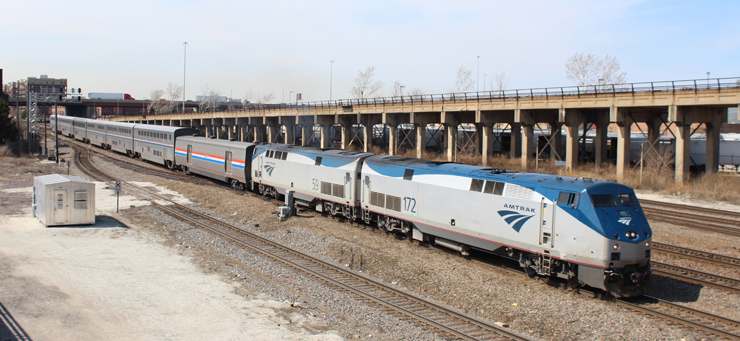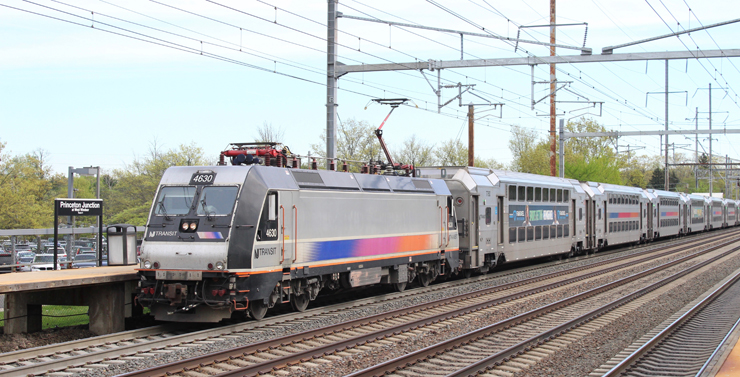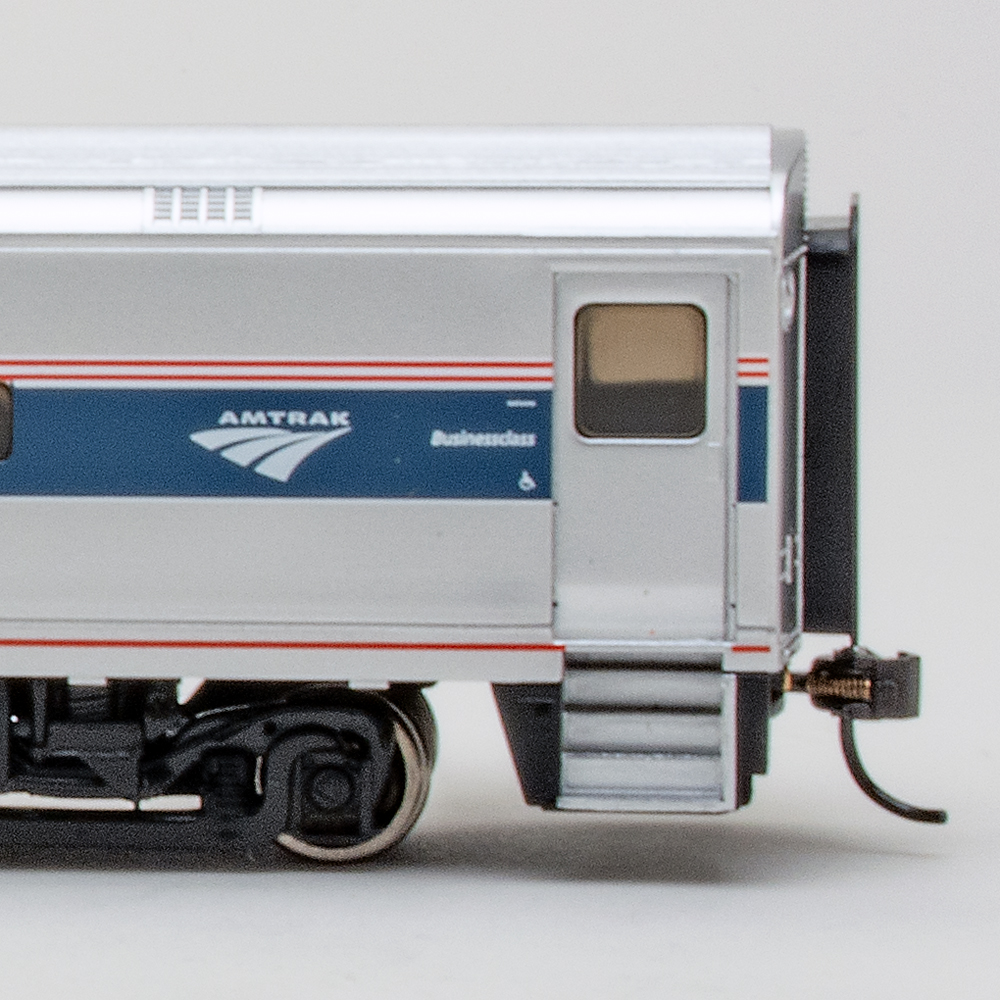WASHINGTON — In a Memorial Day letter to Congress, Amtrak management has asked for $1.475 billion in “supplemental funding” it says is necessary to operate at “minimum service levels across the rail network” and continue capital projects.
Even with this funding — which is addition to $2.04 billion in its budget request for fiscal 2021, submitted before the COVID-19 pandemic decimated ridership and revenue — it says most long-distance routes will be reduced to less than daily service.
The company has subsequently told employees it expects to reduce its workforce by as much as 20%. In a Tuesday message to employees, Amtrak President and CEO William Flynn said the cuts are “to ensure we have a sustainable Amtrak that can continue to make critical investments in our core and long-term growth strategies, while also keeping safety a top priority.”
Flynn said he recognizes that “this activity will cause stress in the organization,” and that management will seek to “minimize the negative impact to our people” by first offering incentives for voluntary separations and retirements before resorting to layoffs.
The message emphasizes that the exact nature of staff or operating reductions is still being formulated, but estimates that patronage for the fiscal year beginning Oct. 1, 2020, will rise to only 50% of 2019 levels.
There have been ridership gains though May and more frequencies are returning in June. But with all Acela Express and most Northeast Regional departures cancelled, April 2020 ridership and revenue was down 98% compared with April 2019. Declines were 95% on state-supported regional trains, and about 85% for the 15 lon- distance trains. Some overnighters are maintaining round trips on the portions of their routes where states have discontinued service.
The letter to Congress lists the cancellations to date and the anticipated 50% figure in asking for the additional $1.475 billion, which it says will also provide funding “in lieu of state and commuter payments that will be difficult for our partners to provide.”
Data accompanying the letter anticipates steady growth through October but then a big dip until February, using 2019 ridership and revenue patterns as a guide, with the assumption that passenger behavior will change. The full letter is available here.
Even with the supplemental funding request, Amtrak says it will shift to less-than-daily long-distance service and significantly reduced Northeast Corridor frequencies to match capacity more closely to demand,” saying it would expect to restore frequencies in both areas “as demand returns to pre-COVID levels … subject to adequate funding.”
Management estimates it will save $500 million in what it characterizes as “self-help cost reduction activities” from frequency and capacity elimination ($150 million) and workforce cuts ($350 million).
An appendix labels all long-distance trains except Auto Train “at risk” without the supplemental appropriation. With the additional funds, the only specific changes the document spells out are consolidation of the Palmetto, Silver Star, and Silver Meteor. A possible blueprint for this is occurring through June 2, when — because of CSX trackwork — the Meteor runs Monday through Thursday and the Palmetto Friday through Sunday via Charleston, S.C., and the Star operates on its route through Raleigh, N.C., and Columbia, S.C. only on the weekends. This preserves daily service between the Northeast and Florida, but creates uncertainty and inconvenience for intermediate-stop patrons.
The company’s worst performing long-distance routes are two triweekly trains, the New Orleans-Los Angeles Sunset Limited and the New York-Washington-Chicago Cardinal. They produce just three days of revenue to seven days of route costs — themselves the product of the company’s opaque fully-allocated accounting. In contrast, most Northeast Corridor expenses are capitalized and don’t flow to each train departure as they do for long-distance and state-supported trains.
Cutting frequencies to three or four days per week was suggested to then-incoming Amtrak President Tom Downs in 1994, when Amtrak’s budget was sharply reduced by the Clinton Administration. Consulting firm Mercer Management Consultants projected that some of the ridership lost on days a train didn’t operate would “claw back” to the days when there was still service. That didn’t happen, while route costs remained high. The service reductions were soon reversed, once “product lines” were established that were responsible for each train’s revenue and expenses.
Still unknown is how much service states will restore on the corridors they sponsor, given already-stretched state finances. As of now, most service reductions are in place on www.amtrak.com only through Sept. 30, with pre-pandemic schedules shown beginning Oct.1.
Amtrak projects it will charge states $495 million in operating and capital costs for fiscal 2021, and with expenses capped at 80% of the fiscal 2019 amount, management wants $260 million from Congress to make up the company’s shortfall.
It also seeks to have the federal government pick up $229 million in commuter payments from the 10 operators that utilize portions of Amtrak’s Northeast Corridor, and to give the states flexibility to use Highway Trust Fund money for capital projects.
Trains News Wire will report and analyze details as they become available.
















While I don’t always agree with Mr. Landry, I agree with his comments on discontinuance.
Gerald, Of course government can continue to print money. But, don’t forget that is what Weimar Germany did in the 20s and Zimbabwe did a decade ago. The Weimar economy collapsed leading to the Nazi Regime, and the Zimbabwean dollar no longer exists. Zimbabwe uses US dollars today. Printing money leads to inflation, the loss of savings and retirement funds, etc., etc. This is Basic Economics 101. Print more dollars, destroy the dollar. Insane.
Break Amtrak up in at least two pieces. I agree that a NEC right of way and other assets should be directly operated by the DOT. Amtrak should be just another user to be billed. The rest of the country, Amtrak II headquartered in Chicago.
The conflict of the NEC verses everything else has gone on long enough. Amtrak has accomplished its mission to save the NEC. It’s now time to relieve Amtrak of its responsibilities to operate and maintain the corridor. The NEC is the property of USDOT, purchased in conjunction with the creation of Conrail. USDOT should establish a NEC Railway Development Corp., modeled after the St. Lawrence Seaway Development Corp, to maintain, control, and further develop the NEC infrastructure. Amtrak would become another user like SEPTA, NJT, etc. This would free up resources to devote to improving the network outside of the NEC.
don’t know Amtrak always crying about money they should just go out of business they remind me of the post office saying they need more funding all the time
This tri-weekly LD schedule proposal was a failure in the 1990’s it does not save money it only results in more losses. One solution to alleviate this fiscal issue is to remove the NEC exemption from PRIIA they have used the national network & state sponsored funds as their own personal ATM long enough, why should the rest of the country comp the NEC when other states will probably have to reduce funding for their own svc & those with only daily service will receive even less service. It time the NE states take a bite from the same big s**t sandwich that currently being passed around.
GERALD – I agree with your post.
Amtrak is asking Congress for another FY 2020 appropriation and threatening massive cuts to its system even if that is approved! While they suggest these cuts might someday be reversed they offer no hint of when, nor how.
I concur with Gerald and Jeffrey’s points – invest now, and massively, in infrastructure when funding and interest rates are dirt-cheap. Spit off the NEC from the NRPC’s books, and go big – nationally.
Charles, the one thing the American public doesn’t understand, nor does Congress apparently, is that we can continue to print money when it’s needed. America will never default because of the fact we can continue to print money, none other than the Oracle of Omaha explained this in an interview that is easily found. It’s to bad the people with the purse strings in Washington don’t understand this, it’s the perfect time to put forth a 2 Trillion dollar infrastructure bill, and once and for all fix the legislation that governs Amtrak and make it a permanent one time bill, including a permanent funding mechanism for operations, a separate funding mechanism for capital costs(both infrastructure and equipment) and a definitive rule on how the nations railroads are to treat passenger trains(shouldn’t be a problem keeping them on time right now with no freight traffic).
ANNA – When Mr. Flynn was appointed some months back at a time that was also the onset of the COVID issue, I posted that Flynn actually had an opportunity to run a nationwide system. Repeat he had an opportunity. Why did I say this? Because staring with COVID money actually does grow on trees in Washington DeeCee. In the past five decades one or another administration (Nixon, Carter, Trump whatever) tried to wring money out of Amtrak’s annual subsidy. Now money is no longer an issue in DeeCee. Fiat money is printed in multiples of a trillion dollars. A few billion for Amtrak isn’t even a rounding error these days, it’s pocket change. As it turns out, I was wrong. It appears now that there will be cuts. I’m not putting it on Flynn because he’s one person. There’s the BoD, the Congress, the Trump administration, etc. So I repeat what I have always believed:- In transportation, one expands to prosperity, one cuts to bankruptcy. Run the trains twice daily or pick up your locomotives and go home, those are the two choices.
Unfortunately we are all in for a very wild ride. I can see Amtrak, not getting the farebox recoveries (or ridership) theyt had projected, making cuts in an effort to simply survive. I don’t have to like it, but it is reality.
Less than daily service makes planning a cross-country trip much more difficult, especially in regard to stopovers and connections. Except for the most ardent railfan, most people won’t want the hassle.
Less than daily is slo-mo discontinuance. Each reader can decide whether or not there should be LDs. I’m here to tell you whether or not you support the LDs you won’t have them.
Less than daily service on the long distance routes will likely be unsustainable. If we can get past the mindset that this virus is going to kill us all (and I’m not denying it’s seriousness) the passengers will return.
These are tough times, but this clearly reflects Amtrak’s unspoken internal belief that the NEC is and should be its primary focus.—Jackson McQuigg